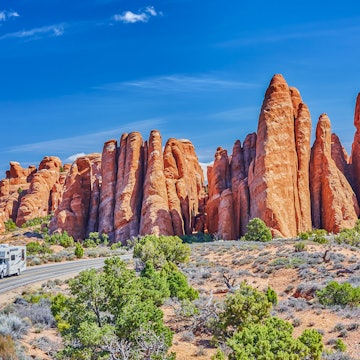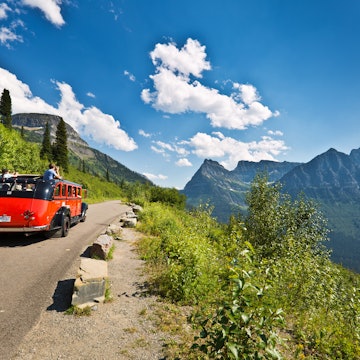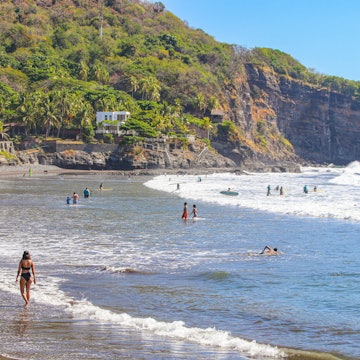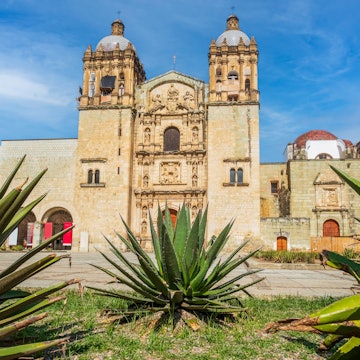
6 epic road trips in Mexico



Monte Albán ruins, Oaxaca, Mexico. Francky38/Shutterstock
Mexico lends itself to sweeping road trips through diverse landscapes and historic sites. Winding through the country's most stunning regions, these classic itineraries take you to jungle-set Maya ruins, dramatic turquoise coastlines and culturally rich cities, not to mention a slew of remote places and small villages best reached by car.
There's plenty of great cuisine, coffee, chocolate and mezcal to discover along the way, as well as chances to see wildlife like whales, turtles and birds. These are the best road trip routes in Mexico.

1. Baja California
Best for coastal views
Start/Finish: Tijuana – Los Cabos
Approximate distance: 1600km
Graced with astonishing desert-meets-sea landscapes, otherworldly rock canyons and traffic-free highways, Baja is made for road-tripping. As you traverse the world's second-longest peninsula, the road zigzags between the coastlines of the Pacific Ocean and the Sea of Cortez, offering glimpses of a Mexico that time forgot. Consider a road trip in February or March when you can spot blue whales – the largest animal on the planet – off the coast.
Start the multi-day tour in Tijuana, indulging in craft beer, streetside tacos and sophisticated art while exploring the mural-embellished side alleys off Avenida Revolucíon. Take a detour to the Valle de Guadalupe vineyards before venturing south the next day to laid-back beach town Ensenada. (Its lived-in cantinas with their saloon-bar-style doors and polished wood floors claim to be the birthplace of the margarita.) Further south await the pristine islands of Loreto with some of the most biologically diverse waters on earth.
From there, you’ll pass several stunning beaches before heading back inland until you veer back toward the coast and La Paz. Spend a day or two enjoying the laid-back malecón (beach promenade) or hike in the nearby Sierra de la Laguna. Spend another day kayaking, swimming or snorkeling around the island of Espíritu Santo, just north of La Paz, or visit its sea lion colony.
From La Paz, the road splits west to surf haven Todos Santos and southeast to Cabo Pulmo, Baja's top dive site. On your final stop, celebrate the long journey in the festive resorts of Los Cabos.
Planning tip: Be aware that in Baja, agencies charge drop-off fees when a rental vehicle is returned to a different location. Factor the additional fee into your budget to avoid a long trip back to your starting point.

2. Mexico's South
Best for culinary adventures and historic ruins
Start/Finish: Mexico City – Mérida
Approximate distance: 2960km
This classic journey takes you to glorious beaches and offers superb cultural, nature and R&R experiences, including ancient pyramids, cultured cities, historic Maya sites and jungles. After some excitement in Mexico City, drive south and stop for lunch in culinary capital Puebla, known for its exquisite moles (traditional Mexican sauce and marinade). About 4 hours away lies cultural colossus Oaxaca City, yet another foodie paradise and a great base to visit the ancient Monte Albán ruins.
It’s worth the long, winding drive from Oaxaca to one of the relaxing beach spots on the coast: Puerto Escondido, Mazunte, Zipolite or remote Parque Nacional Lagunas de Chacahua. Enjoy a few days of sun, surf and sand before heading east to the mountain city of San Cristóbal de las Casas.
From there, drive to Palenque, one of the most stunning ancient Maya cities. Head into the Lacandón jungle to visit local communities and the Yaxchilán ruins. From Palenque, take a 5-hour drive to Campeche to spend the night. The next day, it’s a 2.5-hour drive to Mérida, the best base to access the Uxmal ruins. You can combine your trip with the next route along the Yucatán Peninsula.
Planning tip: The road between Palenque and San Cristóbal de las Casas (Hwy 199), particularly between Ocosingo and Oxchuc, is often not considered safe. Although uncommon, highway blockades and holdups do occasionally occur. Check local alerts before leaving, and avoid driving at night.

3. Yucatán Peninsula
Best for cenotes and Maya ruins
Start/Finish: Cancún – Puerto Morelos
Approximate distance: 1100km
The famous Yucatán Peninsula faces both the Gulf of Mexico and the Caribbean. Forests cover 65% of its interior, and this loop route showcases the most fascinating sights, from jungle ruins and cenotes (limestone sinkholes) to old-world cities and white-sand beaches hugging an aquamarine coastline. As you roll west from Cancún, stop in Valladolid for a dip in an enticing cenote (the Maya believed these natural pools to be gateways to the underworld).
Nearby, don't miss the impressive Maya ruins of Chichén Itzá, but get there early to beat the crowds. Foodies will be licking their chops in Mérida, Yucatán's cultural capital that wows visitors with its extraordinary regional cuisine and vibrant cultural scene.
Next, head southeast to enjoy a leisurely cruise through rolling hills dotted with Maya ruins on the seldom-visited Ruta Puuc. East of Maya country, along the Mexican Caribbean, you'll encounter the impossibly blue waters of Laguna Bacalar, Tulum's dramatically situated clifftop ruins and primo reef diving in Cozumel and Puerto Morelos.
Planning tip: You’ll always encounter steamy days but November to March is slightly cooler. The biggest festivals are from January to April; hurricanes threaten from June to November.

4. Pacific Coast and Copper Canyon
Best for adventure with an epic train journey
Start/Finish: Guadalajara – Chihuahua
Approximate distance: 1790km
Combining some top beaches along Mexico’s Pacific Coast with the vast beauty of Copper Canyon, this road trip is best taken slowly – consider allowing about 2 weeks.
In Guadalajara, Mexico’s second-biggest city, you’ll discover the world of mariachi music, charrería (Mexican cowboys) and excellent cuisine. Spend a day or two exploring the pastel-colored pueblo mágico (magical village) of Tlaquepaque and hip Colonia Americana, then travel beyond the city to Tequila and the Guachimontones pyramids.
From Guadalajara, head to Puerto Vallarta, the Pacific Coast’s safest, largest and most multifarious resort, with beaches, cutting-edge art and water life anchored by whale watching and snorkeling. Edge up the coast to hippie-chic Sayulita, cherished for its surf scene, a potpourri of absorbing boutiques and climbable Cerro de Mono, an extinct volcano.
Next, travel on to Mazatlán and experience the exciting cultural renaissance flourishing in its revamped Old Mazatlán section, with both modern Mexican art and high-quality Indigenous crafts. From there, it's another 408km to reach Los Mochis, the western transport hub for El Chepe's thrilling train ride through Copper Canyon. If you have time to kill, pop into the Museo Regional de Valle del Fuerte and the Jardín Botánico Benjamin Francis Johnston. But don’t miss the train!
A direct journey on El Chepe takes about 10 hours to Chihuahua, but you won’t get the chance to get off and explore the canyon. If you allow 4 days, you can visit some lovely places, including El Fuerte, Bahuichivo, Divisadero and Creel.
Planning tip: Roads in the Copper Canyon region are in relatively good condition and driving can save you a ton of time and money, but proceed with caution as drug cartels control some areas. A normal sedan is good enough to navigate most roads, but a 4WD is recommended if you’re planning to drive down to the canyon floor.

5. Mexico City
Best for volcanoes
Start/Finish: Mexico City – Parque Nacional Cumbres del Ajusco
Approximate distance: 300km
This short but sweet tour packs quite a punch as it circles around the edges of Mexico City's southern border states. Start things off with some serious wow factor on a hike in Izta-Popo Zoquiapan National Park, home to two of Mexico's most impressive volcanoes, the active Popocatépetl and the dormant Iztaccíhuatl (aka El Popo and Izta).
Next, follow the highway southwest for an overnight stay in Tepoztlán, an important Nahuatl center where you can climb up to a clifftop Aztec temple. After that, swing by Cuernavaca and check out Spanish conquistador Hernán Cortés' old digs at the imposing Palacio de Cortés.
Planning tip: Make your final stop at Parque Nacional Cumbres del Ajusco and scale Mexico City's highest peak (Pico del Águila), or simply chill out over a hot champurrado (a comforting corn-based drink) and fresh-made quesadillas at a roadside eatery nestled in the park's fragrant pine forest.

6. Mexico's Heartland
Best for Indigenous history and archaeological sites
Start/Finish: San Miguel de Allende – Xilitla
Approximate distance: 1050km
Start in San Miguel de Allende, spending a day exploring the city’s center, art galleries, boutiques, restaurants and rooftop bars. Take another day in the surrounding hot springs or wineries or allow a half-day at Cañada de la Virgen, all within an hour of town. Use San Miguel de Allende as a base for the next 2 days as you visit Dolores Hidalgo – the central focus of Mexico’s independence – and Guanajuato – with its historic center, pedestrian alleyways and colorful houses. (Avoid driving around in central Guanajuato. Confusing one-way roads can send you in the wrong direction for a while.)
Getting back on the road, head southeast to Querétaro and spend a day or more absorbing the independence heritage and amazing art galleries, aqueduct and coffee scene. Consider an easy 1-hour drive side trip to Tequisquiapan and Bernal or do a formal tour on the Ruta de Vino y Queso (Wine and Cheese Trail).
Next, brace yourself for a long and winding drive to Jalpan in Reserva de la Biosfera Sierra Gorda. Once there, visit at least one of the local missions, explore the area’s many waterfalls, rivers and cloud-forest hikes, or choose just one of the longer walks. If you want to extend your stay, you can visit Sótano del Barro cave.
Continue on to the jungle-strewn town of Xilitla, home to Las Pozas sculpture garden. Descend the mountain via Sótano de las Golondrinas or Sótano de las Huahuas into the region of La Huasteca Potosina.
Planning tip: Be sure to include time for traveling home. It’s a little over a 5-hour drive back to San Luis Potosí, from where you can fly or catch a bus to San Miguel, or about 4 hours to Tampico International Airport.

Tips for driving in Mexico
If possible, stick to driving on the better-maintained cuota (toll) highways. Avoid driving at night because of hard-to-see speed bumps, ubiquitous potholes, poorly lit roads and potential highway robberies.
Other drivers might view red lights and speed limits as mere suggestions, while a left turn from a middle lane is par for the course. Drivers often flash their bright lights or use their left-turn signal to indicate they want to overtake you.
If stopped by traffic police, remain calm and stay in your vehicle; you'll often be let off with a warning. Emergency services can be reached 24/7 by dialing 911 for the police, 065 for an ambulance, 068 in case of fire and 078 for road assistance and towing service.
This article was adapted in part from Lonely Planet’s Mexico guidebook, published in October 2025.















